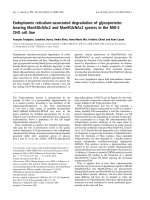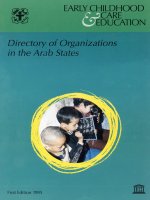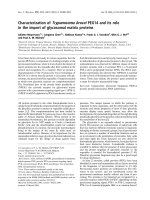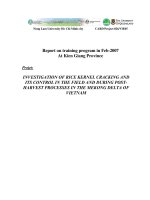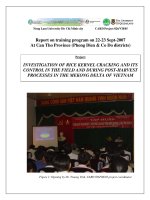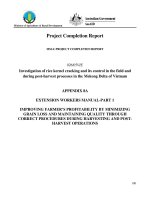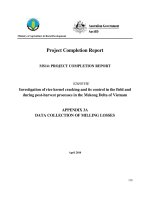Survey of existing farming system and agroforestry practices in the Lohardaga district, Jharkhand, India
Bạn đang xem bản rút gọn của tài liệu. Xem và tải ngay bản đầy đủ của tài liệu tại đây (305.92 KB, 9 trang )
Int.J.Curr.Microbiol.App.Sci (2019) 8(9): 1625-1633
International Journal of Current Microbiology and Applied Sciences
ISSN: 2319-7706 Volume 8 Number 09 (2019)
Journal homepage:
Original Research Article
/>
Survey of Existing Farming System and Agroforestry Practices in the
Lohardaga District, Jharkhand, India
Bijay Kumar Singh1*, P. R. Oraon1, Shashi Ranjan2,
Abhay Kumar3 and Kanchan Kumar Suman4
1
Department of Silviculture and Agroforestry, 2Department of Basic Science and Humanity,
3
Birsa Agricultural University, Ranchi, Jharkhand, India
4
Department of Forest Products and Utilization, Faculty of Forestry, India
*Corresponding author
ABSTRACT
Keywords
Agroforestry,
Agrisilvicultural,
Agrohorticultural,
Monthly Income,
Land Holding
Article Info
Accepted:
18 August 2019
Available Online:
10 September 2019
Agroforestry has been recognized as one of the important systems for supporting the
livelihoods of rural farmers. Maximum number of male population was 55.05% female
population was 44.95% in survey area. Maximum age class 30-40 (48.75%) followed by
age class 40 – 50 (23.75%), maximum 51.25% of respondents belong to medium size
family followed by 35.00% in small size family. Maximum 65% of respondents were
scheduled tribe followed by 28.75% in backward caste, maximum 32.50% of respondents
were under Rs. 3001-5000 monthly income followed by 30.00%, maximum 50.00% of
respondents was 1-2 ha land holding followed by 37.50% in 2-4 ha. In Agrisilviculture
system found tree crop like Artocarpus heterophyllus, Azadirachta indica, Dalbergia
sissoo, Gmelina arborea, Leucaena leucocephala, Melia azedarech, Syzygium cumini,
Tectona grandis and agriculture crop l;ike Triticum aestivum, Brassica nigra Pisum
sativum, Zea mays, Oryza sativa, Solamum tuberosum, Lycopersicon esculentum. In
agrihorticulture system grow tree like Artocarpus heterophyllus, Litchi chinensis,
Mangifera indica, Syzygium cumini and agriculture crop like Lycopersicon esculentum,
Solanum melongena, Zingiber officinale, Capsicum annuum, Colocasia schott. Different
agroforestry practices fulfilled the demand of rural households and extra income sources.
However, only few households adopted high income based agroforestry activities. It
should be extended to all households and need to be supported by government.
Introduction
Agroforestry is an age old practice followed
by every rural household for supporting their
local needs which also maintains the
microclimate and aesthetic of the surrounds.
Agroforestry focuses on the wide range of
trees grown on farms and other rural areas.
Among these are fertilizer trees for land
regeneration, soil health and food security;
fruit trees for nutrition; fodder trees for
livestock; timber and energy trees for shelter
and fuel wood; medicinal trees to cure
diseases and trees for minor products viz.
1625
Int.J.Curr.Microbiol.App.Sci (2019) 8(9): 1625-1633
gums, resins, or latex products, Many of these
trees are multipurpose, providing a range of
benefits. Scientific agroforestry emphasized
for increase in the productivity from unit area
by incorporation of tree components in
intensive
agricultural
practices
like
agrisilviculture,
agrihorticulture,
Silvopastural, agrisilvihorticulture, etc. these
practices by and large applied to large farm
holding but small land holders are interested
in home garden type model which is most
primitive and followed in all around the
tropics (Leakey 1996). According Forest
Survey of India (2013), the forest cover in the
country is 6,96,898 km2, constituting 21.23%
of its total geographical area. Out of this,
dense forest constitutes 2.54% and open forest
8.99%. The forest cover is the hilly district is
only 38.34% compared with the desired 66%
area. India is estimated to have between
14,224 million and 24,602 million trees
outside forests spread over an equivalent area
of 17 million ha (Singh and Pandey, 2011).
The national agriculture policy (2000)
emphasized the role of agroforestry for
efficient nutrient cycling, nitrogen fixation,
and organic matter addition and for improving
drainage and underlining the need for
diversification by promoting integrated and
holistic development of rainfed area on
watershed
basis
through
involvement
community tegument biomass production
through agroforestry and farm forestry.
Agroforestry system involves basically three
processes of growth, management and
interactions. Growth relates to trees, crops,
pastures and animals; while management
refers to the effective and efficient use of
climate, water, soil, plants and animals as the
case may be. Interactions on the other hand
refer to the tree-crop, tree-pasture, and treeanimal associations. Furthermore, when the
growth of trees is combined with cultivation
and sometimes with animals, it provides an
essential part of an agricultural system which
facilitates both productive and protective
functions (Young, 1989).
Materials and Methods
Lohardaga District is situated in the southwest
portion of the Jharkhand state. It is lies at 23°
21' 0" North, 84° 48' 0" East longitude. The
general climate of the region is sub-tropical
and annual average temperature is 23 0C the
highest temperature goes to 42 0C in summer
and lowest of 8 0C in winter. The site receives
annual rainfall of 1000 to 1600 mm. The mean
relative humidity is about 76.28% in the area.
The monsoon breaks out in the middle of June
and last till mid October. Multi stage random
sampling was adopted to select the
households. Bhandra block was selected
randomly in the first stage. Four panchayats
were selected randomly for the study. A list of
villages was prepared for each selected
panchayat. From each village, twenty
households were selected using simple
random sampling. Thus, a total of 80
households were selected for the purpose of
this study. Each village was visited before
administering the questionnaires. Interviews
were conducted during the evenings (near
dinner time) and early mornings, for farmers
who were available only during these times.
The questionnaire was then finalized on the
basis of validity, suggestions, corrections and
comment of the research supervisor and
experts. A few modifications and reduction in
the number of questions were done taking
cognizance of time constraints of the
interview.
Results and Discussion
Socioeconomic profile
The Socioeconomic study of the area is shown
in Table 1.The table indicated that the
maximum number of male population was
55.05% female population was 44.95% in
survey area. Maximum age class 30-40
1626
Int.J.Curr.Microbiol.App.Sci (2019) 8(9): 1625-1633
(48.75%) followed by age class 40 – 50
(23.75%), maximum 51.25% of respondents
belong to medium size family followed by
35.00% in small size family. The reading the
size of family reveals that majority of small
and medium families have been observed
indication a clear cut dominance of small and
medium
families
among
respondents
confirming the report of Bisaliah (1995),
Ranjan et al., (2017), Thakur et al., (2018) and
Kumar et al., (2018). Medium size of family is
indicated that the tribals have a tendency to
live in nuclear family as also reported by
Sachidananda (1979) and Srivastava (1982).
Kutcha type of house was found maximum
(66.25%) followed by Mixed house type
(27.5%), maximum 33.75% of respondents
was intermediate followed by 26.25% in high
school. The literacy status of people residing
in the research area are literate or having
elementary level education. In Bangladesh
44% of all house hold heads are literate and
also mention that high literacy level, strongly
correlated with use of more services it also
indicate and eliminates of empowerment and
awareness Rasid (2002). Maximum 65% of
respondents were scheduled tribe followed by
28.75% in backward caste, maximum 32.50%
of respondents was under Rs. 3001-5000
monthly income followed by 30.00%,
maximum 50.00% of respondents was 1-2 ha
land holding followed by 37.50% in 2-4 ha.
Dwivedi et al., (2007) the marginal farmers
had an average land holding of 0.71 ha, the
small farmer had a land holding of 3.14 ha
while the medium to large farmer holding size
was 3.46 ha thus the overall holding size of
the sample farmers in Aligarh district was 1.52
ha. Chauhan and Ingle (1988) studied the role
of farm forestry in Akola district of Vidharba
region (Maharastra) and reported that majority
of farmers have small landholding, none of the
small and marginal farmers had adopted farm
or agroforestry (Marwar et al.,1993). In
Ranchi district the average land holding of the
farmers ranges between 2.79 to 3.75 acres in
all surveyed village (Jha and Ranjan, 1993).
Saxena (1996) reported in North West India
52% of the large farmers (those owning more
than 2.5 ha.) 17 5 of the small farmers
(owning between 0.5 and 2.5 ha) and 5% of
tiny farmers (with less than 0.5 ha) planted
trees on their farm under agroforestry concept.
Singh and Dagar (1996) have presented survey
of agroforestry system undertaking in the
Mussorie hills near Dehradun (U.P.). About
80% of landholdings were < 1ha, 15% were 1
- 2.5 ha and 5% were 2.5 - 10 ha. The systems
identified
were
agrisilviculture,
agrihorticultural,
agrisilvihorticultural,
silvipastoral and homesteads. This finding
supports the present fining become percentage
of small landholding are more than large
landholding.
Maximum
68.75%
of
respondents were their own source and
minimum was 31.25% were purchased from
markets. Similarly, Dwivedi et al., (2007) the
majority of farmers (50.6%) farm trees where
a prime source of fuel wood and hence they
protected the same in Western Uttar Pradesh
and in the Bastar region of Chhattisgarh
fulfilling the all basic requirement from
agroforestry practices like food, fodder and
fuel etc. and also getting extra benefit or
income (Hemrom and Nema, 2015).
Maximum 96.25% of mode of cattle feeding
was both stall feeding and grazing and
minimum was 3.75% were only grazing,
maximum 60% of respondents were mixed
crop followed by inter crop 22.5%. According
to Hemrom and Nema (2015) agroforestry can
be seen in all part of Bastar region of
Chhattisgarh.
The farmers are planting trees inside and
outside their farm and practices many
agroforestry
practices
like
boundary
plantation, headge row and intercropping etc.
Similar result find in Zaman et al., 2010,
Ranjan et al., 2017, Kumar et al., 2018,
Kumari et al., 2018 and Thakur et al., 2018.
1627
Int.J.Curr.Microbiol.App.Sci (2019) 8(9): 1625-1633
Table.1 Socioeconomic profile
Component
Male
Femal
20 - 30
30 - 40
40 - 50
50 - 60
Small
Medium
Large
Kutcha
Mixed
Pucca
Illiterate
Elementary
High school
Intermediate
College
Scheduled tribe
Backward caste
General
1001 - 3000
3001 - 5000
5001 - 7000
7001 - 9000
Below 1 ha
1 to 2 ha
2 to 4 ha
4 to 10 ha
Own source
Purchase source
F
Population
311
254
Age class
11
39
19
11
Size of Family
28
41
11
House type
53
22
5
Education attainment
8
15
21
27
9
Social class
52
23
5
Monthly income
24
26
20
10
Land size
5
40
30
5
Source of fodder and fuel
55
25
Mode of feeding cattle
1628
%
55.05
44.95
13.75
48.75
23.75
13.75
35.00
51.25
13.75
66.25
27.5
6.25
10
18.75
26.25
33.75
11.25
65.00
28.75
6.25
30.00
32.50
25.00
12.50
6.25
50
37.5
6.25
68.75
31.25
Int.J.Curr.Microbiol.App.Sci (2019) 8(9): 1625-1633
Stall feeding
Grazing only
Both
Sole crop
Mixed crop
inter crop
0
3
77
Cropping pattern
14
48
18
0.00
3.75
96.25
17.5
60
22.5
Table.2 Socioeconomic profile
Component
Agriculture
Labour
Private job
Construction work
Other if any
Agriculture
Horticulture
Agroforestry
Fallow
Other purpose
Multiple answer #
F (n= 80)
Occupation
80#
32#
8#
12#
16#
Land use practics
80#
19#
37#
53#
34#
%
100
40
10
15
20
100
23.75
46.25
66.25
42.5
Table.3 Soil properties of different land use practices
S.N.
Treatment
pH
O C (%) Nitrogen
Phosphorus
Potash
1.
Agrisilvicultural
6.20
0.423
255.27
17.24
243.22
2.
Agrihorticultural
6.10
0.386
236.09
14.79
238.70
3.
Silvipasture
6.13
0.304
216.03
15.78
223.02
4.
Homegarden
6.18
0.420
251.03
15.25
238.48
5.
Sole tree
6.10
0.332
209.54
15.93
204.02
6.
Sole crop
6.10
0.442
256.29
20.06
255.58
7.
Barren land
5.47
0.258
177.190
10.45
185.37
SE m ±
0.058
0.011
5.046
0.036
4.780
CD at 5%
0.172
0.034
15.107
1.078
14.313
CV %
1.906
6.195
4.411
4.605
4.203
1629
Int.J.Curr.Microbiol.App.Sci (2019) 8(9): 1625-1633
Table.4 Tree and agriculture crop combination in Agroforestry System
Agroforestry
system
Agrisilviculture
System
Tree species
Agricultural crop
Artocarpus heterophyllus, Azadirachta indica,
Dalbergia sissoo, Gmelina arborea, Leucaena
leucocephala, Melia azedarech, Syzygium
cumini, Tectona grandis
Agrihorticulture Artocarpus heterophyllus, Litchi chinensis,
Mangifera indica, Syzygium cumini
System
Silvipasture
system
Homegarden
system
Dalbergia sissoo and Mangifera indica
Triticum aestivum, Brassica nigra Pisum
sativum, Zea mays, Oryza sativa,
Solamum tuberosum,
Lycopersicon
esculentum
Lycopersicon esculentum, Solanum
melongena, Zingiber officinale,
Capsicum annuum, Colocasia schott
Cynodon dactylon and Cyperus scariosus
Artocarpus heterophyllus, Azadirachta indica, Solamumtu berosum, Allium cepa,
Dalbergia sissoo, Gmelina arborea, Litchi Solanum melongena, Capsicum annuum,
chinensis, Mangifera indica, Syzygium cumini Zingiber officinale Colocasia schott,
and Tectona grandis
Lycopersicon esculentum and Zea mays
The data has indicated in the Table 2 the
respondents of all Bhandra were engaged in
Agriculture (100%). Besides agriculture, the
respondents are engaged in labour (40%),
private job (10%), constructions work (15%)
and other (20%). As per Behr and Lee (2004)
approximately 25% of these households in
Periyar Tiger Reserve Kerala also engaged in
off-farm activities. The number of working
people engaged in business and government
service profession was found very few. The
study has indicated that in all the respondents
of all Panchayats were engaged in agriculture
(100%). Besides agriculture, the respondents
are engaged in horticulture (23.75%),
agroforestry (46.25%), fallow land (66.25%),
and in other purpose (42.5%). Almost similar
observation had been reported by Rasid (2002)
in Bangladesh indicated that involvement in
agriculture in most household’s are the
primary occupation found in observation
about 63% of household depend on one form
of agriculture or another ranging from
agriculture producing crops on their own land
to selling labour for agriculture, 59% of
occasionally poor household depend upon
agriculture production on their own land, 23%
depend on a combination of production from
their own land and sharecropping, while 44%
of the always poor household work primarily
as agriculture labourers in Bangladesh. Similar
study has been carridied out by Saxena (1996)
in North West India, where he has noticed
52% large farmar (more than 2.5 ha), 17%
small farmers (between 0.5 - 2.5 ha) and tiny
farmer (less than 0.5 ha) planted trees on their
farm under agroforestry concept. Similar
result finds in Zaman et al., 2010, Islam et al.,
2012, Kumar et al., 2018 and Thakur et al.,
2018.
Soil properties of different land use
practices
The soil properties obtained from different
land use practices in Bhandra block is
presented in Table 3. The soil properties like
pH, organic contents (%), nitrogen,
phosphorus and potash were analyzed under
different treatment i.e. in agrisilvicultural,
agrihorticultural, sole tree, sole crop and
barren land. Perusal of data has indicated that
the highest pH was found in agrisilvicultural
system i.e. 6.2 whereas minimum pH was
found in barren land i.e. 5.47. The organic
content (%), nitrogen, phosphorus and potash
1630
Int.J.Curr.Microbiol.App.Sci (2019) 8(9): 1625-1633
were found maximum in sole crop because of
regular use of fertilizer in field whereas
nitrogen and potash were found minimum in
sole tree. The phosphorus was found
minimum in agrihorticultural system whereas
the organic content (%) was found minimum
in barren land. Statistically organic content
(%), nitrogen, phosphorus and potash were
found significant at 5% among the treatments.
Mishra et al., (1982) have reported soil
physical properties pH, nitrogen and organic
carban after four year under silvipastoral
system in calcaseous soil. Similarly, Sharma
and Prasad (1980) found growing Sissoo trees
proved to be beneficial in improving the site
by increasing organic carban and nitrogen
sustainability as compared to fallow land.
Growing of Sissoo in association with acable
crops has been shown to providing
sustainability to the traditional acable for in
dry region by Subramanyam et al., (1991).
The beneficial effects of trees has been shown
by authors such as Khonje (1989) has
compared soil characterististics under
agroforestry Leucaena leucocephala, Gmalina
arborea, Eucalypyus camaldulensis and
monocropping
(Maize)
and
noticed
improvement in pH or organic carban under
tree environment. Similary, Rai et al., (2001)
reported higher level of organic carban in
silvipastoral system as compare to pasture
alone.
Tree and agriculture crop combination in
Agroforestry System
Tree and agriculture crop combination was
indicated in table 4. In Agrisilviculture system
found tree crop like Artocarpus heterophyllus,
Azadirachta indica, Dalbergia sissoo,
Gmelina arborea, Leucaena leucocephala,
Melia azedarech, Syzygium cumini, Tectona
grandis and agriculture crop l;ike Triticum
aestivum, Brassica nigra Pisum sativum, Zea
mays, Oryza sativa, Solamum tuberosum,
Lycopersicon esculentum. In agrihorticulture
system they grow tree crop like Artocarpus
heterophyllus, Litchi chinensis, Mangifera
indica, Syzygium cumini and agriculture crop
like Lycopersicon esculentum, Solanum
melongena, Zingiber officinale, Capsicum
annuum, Colocasia schott. In silvipasture
system Dalbergia sissoo and Mangifera
indica, and grasses Cynodon dactylon and
Cyperus scariosus where as in homegarden
system tree crop were found Artocarpus
heterophyllus, Azadirachta indica, Dalbergia
sissoo, Gmelina arborea, Litchi chinensis,
Mangifera indica, Syzygium cumini and
Tectona grandis and agricultural crop like
Solamumtu berosum, Allium cepa, Solanum
melongena, Capsicum annuum, Zingiber
officinale Colocasia schott, Lycopersicon
esculentum and Zea mays. Similar study found
in Hemrom and Nema, 2015, Toppo et al.,
2016, Lakra et al., 2017, Kumar et al., 2017,
Singh and Oraon 2017 and Kumar et al., 2018.
Traditional agroforestry systems and practices
associated with them plays an important role
in securing the sustainable livelihood security
of the rural people of Bhandra block. Most of
the people are doing agriculture and labour
work in the area. Approx 50% household
doing agroforestry in block. Maximum
number of people having land holding size per
household is 1-2 ha. They should provide
scientific guidance to the farmers about
suitable tree species grown on agricultural
land with agricultural crops, their silvicultural
operations and tree management practices
along with free supply of seeds and seedlings
and loan schemes for the promotion of
agroforestry. Surveys are required to be
conducted in Lohardaga district more
awareness and training programme on
scientific methods of agroforestry are required
so as to increase income and employment
generation at farm level. The Govt. should
take proper initiative to supply credit and loan
facilities to farmers and arrange training and
workshop on cultivation and management of
agroforestry.
1631
Int.J.Curr.Microbiol.App.Sci (2019) 8(9): 1625-1633
References
Bisaliah, S. (1995). Decision making on Farm
Forestry: Role of Socio Economic and
Institutional factors; FarmForestry in
South Asia Ed. N.C. Saxena & Vishwa
Ballabh Saga Publication, pp. 219 244.
Chauhan P. S. and Ingle, P. O. (1988). Role of
farm forestry in meeting the fuel wood
requirement of the villages. Advances
in Forestry Research in India, Vol. II
1988 ed. Ram Prakash. IBD.
Dwivedi P. R., Karemulla, K., Singh R., Rizvi,
R.H. and Chauhan J. (2007). SocioEconomic Analysis of Agroforestry
Systems in Western Uttar Pradesh.
Indian Res. J. Ext. Edu. 7 (2&3), May
& September.
FSI, (2013) Forest Survey of India, Ministry
of Environment and Forest, Govt. of
India. Dehradun.
Hemrom, A. and Nema, S. (2015). A study on
traditional
agroforestry
practices
existing at Bastar region of
Chhattisgarh. International Journal of
Multidisciplinary
Research
and
Development, 2(3):56-64.
Islam, W. M., Islam, M.M. and Sadath N. M.
(2012) Contributions of Agroforestry
Practice Towards Reducing Poverty at
Kedhabpur Upazila of Jessore District
– A case study, J. Environ, Sci. &
Natural Resources, 5(2): 267-274
Jha, L. K. and Ranjan (1993). Impact of
farm/agroforestry on village socioeconomic life (A case study),
Agroforestry – Indian persective. Pp
277 – 300.
Khonje, D.J. (1989). The tree potential of
Leucaeua Leucocephala in the
agroforestry system in Malawi. Trees
for development in sub Saharan Africa.
Proceeding of a Regional Seminar held
by the International Foundation for
science (IFS), ICRAF House, Nairobi,
Kenya Feb. 20-25, 143-149.
Kumar, A., Sah, R. B., Singh, B. K. and
Oraon, P. R. (2017) Tree Species
Preferences on Agroforestry Practices
in Bishunpur Block of Gumla District,
Jharkhand. Trends in Biosciences
10(40), 8508-8516
Kumar, A., Sah, R. B., Singh, B. K. and
Oraon, P. R. (2018). Socioeconomic
Analysis of Tribal Farmers in the
Gumla District of Jharkhand from
Existing
Agroforestry
Practices
Int.J.Curr.Microbiol. App.Sci (2018)
7(6): 595-604
Kumari, N. Malik, M. S., Kumar, J. and
Kumari J. (2018) Socioeconomic and
Livelihood analysis in the Namkum
Block of Ranchi District, Jharkhand
from
Agroforestry
Practices,
Multilogic in Science, VOL. VIII,
issue special(C) pp: 238-241.
Lakra, T, S., Siddiqui, M.H., Chakraborty,
A.K., Oraon, P.R. and Malik, M. S.
(2018).
Agroforestry
Practices
Feollowed in West Singhbhum
District,
Jharkhand.
Trends
in
Biosciences, 11(4): pp 400 – 406
Leakey, R. R. B. (1996). Definition of
agroforestry revisited. Agroforestry
Today, 8(1): 5-7.
Marawar, S. S,, Ingle, O.P., Mukewar, M. A.
and Deshmukh, G. R. (1993). Socioeconomic analysis of farm forestry in
Vidhana of Maharastra State. Advance
in forestry research in India. Vol – IX
pp 219-232.
Mishra, S. M., Patil, B. D. and Pathak, P. S.
(1982). Comparative differences in soil
properties as a result of growing
different grass legume and tree
combinations, Indian J. Range Mgmt.
3 (1& 2): 71-74.
National Forest Police (2000) Government of
India, Ministry of Environment and
Forest,. New Delhi.
Oraon. P. R., Yadav, M. S. and Siddiqui, M.
1632
Int.J.Curr.Microbiol.App.Sci (2019) 8(9): 1625-1633
H. (2005). Comparative performance
of Agroforestry in Kumharia Village
of Ranchi District. Indian Journal of
Agroforestry. Vol. 7 No. 2: pp 19 -24.
Rai, P., Yadav, S. R., Solanki, R.K, Rao, R.G.
and Singh, R. (2001). Growth and
prouned biomass production of
multipurpose tree species in silvipastoral on degraded lands in semi-arid
region of Uttar Pradesh, India Forest
Tree and Livelihood 11: 347-364.
Ranjan, R., Shekhar, S. and Singh, C.V.
(2017) Diagnostic Survey of Existing
Farming System and Agro Forestry
Practices in the Koderma District of
Jharkhand,
India,Int.J.Curr.Microbiol.App.Sci6(9)
: pp: 1936-1943.
Rasid, D. A. (2002). The finding of the
Northwest
Rural
Livelihoods
Monitoring Project, Care Bangladesh.
pp. 59 - 67.
Sachchidananda (1979). The changing Munda
concept Publication Co. New Delhi.
Saxena, N. C. (1996). Farm Forestry in North
West India – A case study. Indian
Forester, 122 (7):560-569.
Singh, V. P. and Dagar, J.C. (1996)
Agroforestry system for Mussoorie
Hilles Western Himalayas in special
Issue. Indian Forester, 122 (7): 610 –
614.
Singh, V.S. and Pandey, D.N. (2011)
Multifunctional Agroforestry systems
in India: Science based policy options.
RSPCB Occasional Paper No. 4/2011,
Rajasthan State pollution Control
Board.
Srivastava, R. M. (1982) Cattle in Culture and
economy of Tribal Mundas of Bihar.
Ph. D. Thesis (Unpub.) Div. Dairy
Extn., N.D.R.I., Karnal.
Subramanyam, M.V.R., Bheemaiah, G. and
Lsmall, S. (1996). Compatibility of
available crops intercropped Dalbergia
sissoo
For
Sustainable
rained
agriculture. Indian Forester, 122
(7):646-650.
Thakur, P. K., Malik, M. S., Singh, B. K. and
Oraon, P. R. (2018). Assessment of
socioeconomic status of agroforestry
farmers in Giridih District, Jharkhand,
Journal of Pharmacognosy and
Phytochemistry; SP1: 929-932
Toppo P., Raj A. and Jhariya M. K. (2016)
Agroforestry systems practiced in
Dhamtari district of Chhattisgarh,
India, Journal of Applied and Natural
Science 8 (4).
Young, A. (1997). The effectiveness of
contour hedgerows for soil and water
conservation. Agroforestry Forum,
8(4): 224-227.
Zaman, S. Siddiquee, U. S. and Katoh. M.
(2010) Structure and Diversity of
Homegarden
Agroforestry
in
Thakurgaon District, Bangladesh The
Open Forest Science Journal, 3, pp 3844.
How to cite this article:
Bijay Kumar Singh, P. R. Oraon, Shashi Ranjan, Abhay Kumar and Kanchan Kumar Suman.
2019. Survey of Existing Farming System and Agroforestry Practices in the Lohardaga
District, Jharkhand, India. Int.J.Curr.Microbiol.App.Sci. 8(09): 1625-1633.
doi: />
1633
